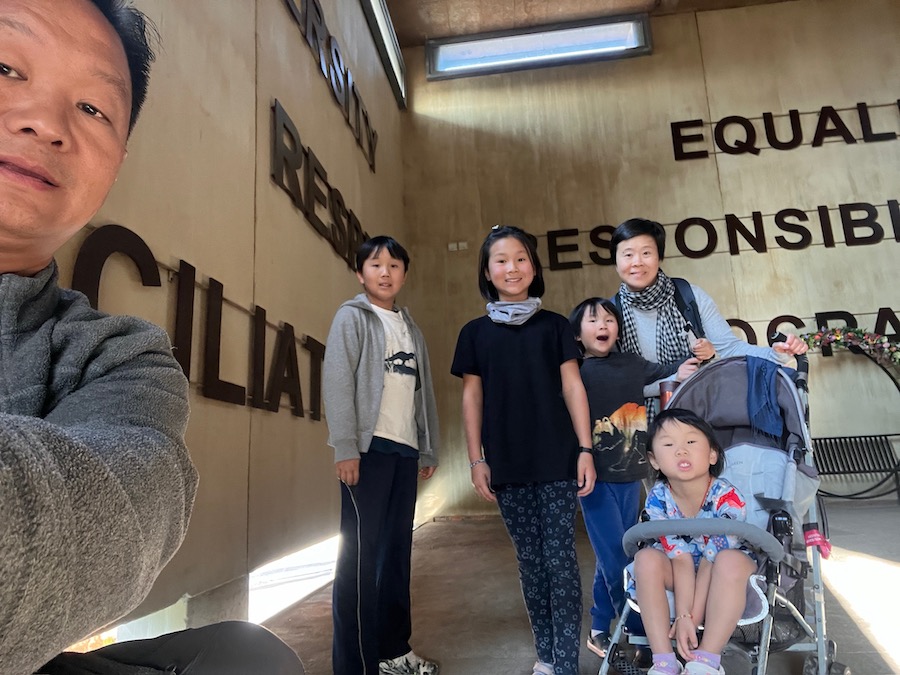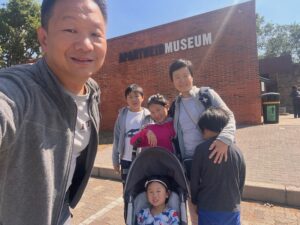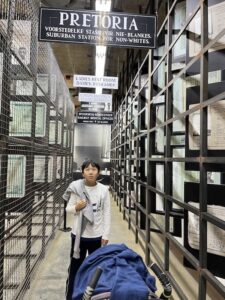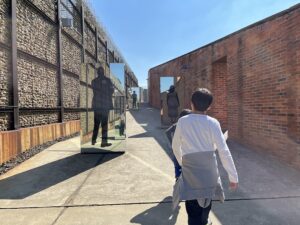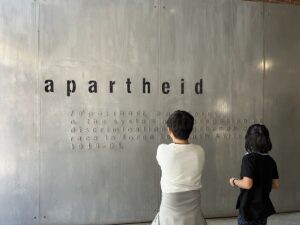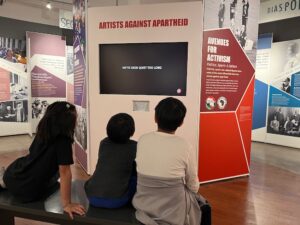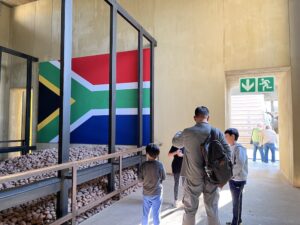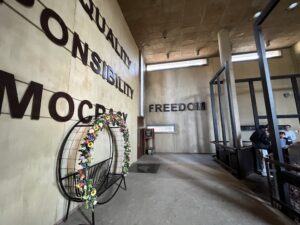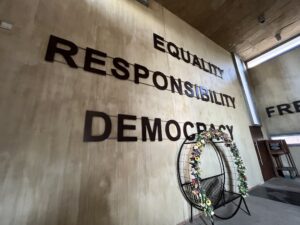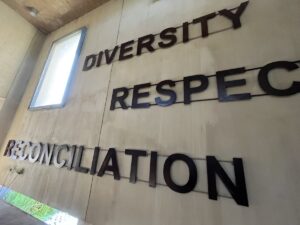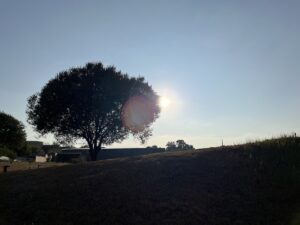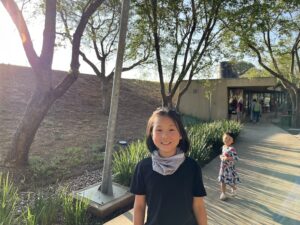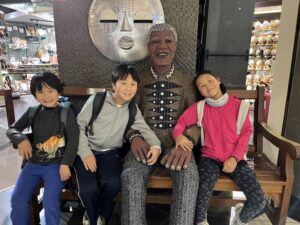During our month in South Africa, I have been reading Nelson Mandela’s autobiography, “A Long Walk to Freedom”. I share the interesting, significant and funny parts of the book with the rest of the family during our long drives through the ever scenic, ever changing coastal roads, endless highveld and bushveld savannas and majestic mountain passes of this country. In this way, we have been enjoying the book together as a family. Throughout these weeks, it is as if we have journeyed through South Africa, guided by the spirit of Mandela and gotten to know the country through his lens of patience, courage, wisdom and love for his land and its people. To honor Mandela and the struggles of this country, I could think of no better way to end our month in South Africa than a visit to the Apartheid Museum.
For more background information on apartheid, please visit DY’s report on South Africa and RY’s report titled “Apartheid and other Governments Doomed to Fail”.
Upon entering the Apartheid Museum, each visitor is presented with a card that designates you as either “White” or “Non-white”. The “Whites” and the “Non-whites” enter the museum through different doors and take different paths. This theatrical entrance sets the tone for the rest of the visit. I was surprised at how much this exercise affected DY who became upset when our family was separated by the cards that we received. He got the “White” card but refused to go in the “White” door and instead, angrily tore up his card. Even though I explained to him that the intention of the card was to show us what life was like during apartheid and assured him that our family would not really be separated, his reaction did not abate.
Given that Nelson Mandela dedicated his life to the struggle against apartheid, in many ways, Mandela’s life paralleled the rise and fall of apartheid. After reading the book, I felt prepared to visit the museum as I could draw many connections between contents of the book and exhibits in the museum. While the book recounted events from Mandela’s perspective, the museum provided a broader view of what was happening at the time. The Nationalist government instituted apartheid in 1948. In 1952, Mandela and fellow African National Congress (ANC) leader Oliver Tambo started South Africa’s first black law practice that helped blacks who had been entangled in unfair and petty apartheid laws. Mandela was imprisoned from 1962 to 1990, for 27 years. During the years that he was in prison, a lot was happening on the outside.
The most impactful part of the museum, to me, was the exhibit titled “Life under Apartheid”. This area of the museum contained enlarged photos taken by Ernest Cole, a black documentary photographer who went into exile in the 1960s, of the daily injustices and humiliations that blacks experienced during apartheid. The photos were published in his book “House of Bondage”, which was banned in South Africa under apartheid.
Some of the photos and accompanying narrative are so haunting that they are hard to forget.
– A child of about 5 or 6 years old trying to learn but facing insurmountable barriers. He is sitting on the floor clutching a board or book, with sweat dripping down his face, in a classroom that is barren.
– A black nanny hugging a white child saying that she loves this innocent child, but she knows that when the child grows up, she will treat her just as her mom does.
– A family with four or five children struggling to get enough to eat as they kneel on the floor beside a single shared bowl of food.
– A man with only one leg hobbling back to the train that will take him to the mines to work, even though he lost that leg in a mining accident.
– A woman with a baby tied on her back blacked out on the street, drunk on the homemade alcohol permitted to blacks in black-only beer halls, as she tried to drink away her miseries.
During the apartheid era, what little freedoms blacks had continued to be gradually taken away. Apartheid laws could be separated into “petty apartheid” and “grand apartheid”. Petty apartheid included segregation in the minutiae of daily life like public building entrances, parks, buses, trains, bathrooms, swimming pools and many others. Every aspect of life was separated for blacks and whites. Grand apartheid included the broader political and social architecture within the country that dictated limitations on land ownership and political rights for blacks. Under grand apartheid policies, the Bantustan policies were created to systematically and forcefully remove blacks from white areas. We learned about forced relocation first-hand when we visited the South End Museum in Port Elizabeth. See our blog post on the South End Museum. From 1960 to 1994, blacks were forced to live in their “homeland” areas while their land was sold to white farmers at low prices. The system was designed so blacks would have no choice but to work as migrant, low-wage laborers in white areas.
Resistance to apartheid continued to grow among black South Africans. In addition to Mandela, there were many courageous South Africans, black and white, who dedicated their lives to the struggle for freedom. A few freedom fighters who were mentioned in Mandela’s book were heavily featured in the museum. Among them was Steven Biko, the founder of the Black Consciousness Movement, a movement centered on black pride and psychological freedom from the overt and latent oppression of living in a white-man’s world. Steven Biko died while under arrest and in police custody.
In his book, Mandela recounts his forming of the paramilitary wing of the ANC called uMkhonto we Sizwe (MK) in 1961 as a reaction to the Sharpeville Massacre in 1960. Although the ANC had adhered to a strategy of passive resistance and non-violence prior to the formation of MK, there were those who advocated for armed resistance. By 1976 after the Soweto uprising, most black South Africans were ready for the next step in the struggle. In that year, the government announced that Afrikaans would become the mandatory language of instruction in black schools. School children in Soweto led a peaceful protest that was met with police brutality that killed hundreds of youths. Soon, youth-led protests erupted throughout the country.
The 1980s were the most violent years during the apartheid era as the government tried to maintain control over wide-spread uprisings and protests by black and some white populations. Many countries began or continued to impose international sanctions against South Africa, which helped to put pressure on the economy. Citizens from all over the world learned about the oppressive regime and came out in support of the freedom movement.
In 1988, Mandela, still in prison, reached out to the government to enter negotiations to end apartheid. In 1989, the more pragmatic FW de Klerk replaced the idealogue PW Botha as President, which paved the way for talks to begin. FW de Klerk recognized that the only way forward for South Africa would be to move toward ending apartheid.
1994 saw the first democratic election in South Africa where citizens of all races were allowed to take part. Mandela was elected President with the ANC (African National Congress) getting 63% of the votes. The nearly half-century of apartheid rule officially ended in South Africa ended in 1996 with the adoption of the new Constitution. The last room of the museum is dedicated to the seven fundamental values of the constitution: democracy, equality, reconciliation, diversity, responsibility, respect and freedom.
We often use these terms casually, without giving it a second thought. To truly understand the meaning of each word is to know what it is like to live in the absence of these rights – democracy, equality, reconciliation, diversity, responsibility, respect and freedom. Behind, underneath and inside these words are the struggles and sacrifices of others that allow the rest of us to take for granted that these are rights.
Life as a black South African during apartheid was nothing short of a horror. It is not a life that I could imagine for myself or for my children. What would I have done if I had been living during apartheid? As a black South African? As a white South African? As a Chinese South African?
Mandela ends his memoir by sharing a reflection that is deep with insight and wisdom. He admits that he was not born a freedom fighter. When he was a boy, he thought that he was free in every sense of the word. He played in the fields and swam in the streams. It was only when he realized the innocent feeling of freedom in his childhood was just an illusion, that he began to yearn for real freedom.
In his youth, his understanding of freedom was superficial. As a student, he wanted the freedom to read what he liked, study what he pleased and stay out late. As a young man, he sought the freedom to distinguish himself in his pursuits, to marry whom he pleased and to follow his ambition.
Then, he began to see that not only was he not free, but all of the people who looked like him were equally caged because of the oppression that surrounded them. It was only then that his understanding of freedom came to embody the true meaning of freedom. Freedom is not just for an individual or for a particular group of people. Freedom, by nature, implies freedom for all.
Eventually, he came to realize that he was not only fighting for the freedom of his people but freedom for all people. Blacks needed to be liberated from apartheid and so too did whites. Both the oppressed and the oppressor both suffer, in different ways, from oppression and hate.
“A man who takes away another man’s freedom is a prisoner of hatred, he is locked behind the bars of prejudice and narrow-mindedness.” All people have the right to live with dignity and self-respect.
***
A heartfelt thank you to Nelson Mandela, a truly remarkable man, whose spirit guided us through our month-long journey in South Africa.
Author
-

Song is the mother of four children. She and her family have stepped away from it all and in September 2023, began traveling the world while homeschooling. Song is an ABC (American born Chinese) and has an undergraduate degree from Cornell and an MBA from Harvard. She is an entrepreneur and an educator. Her hobbies include learning, traveling, reading, cooking and baking, and being with children.

